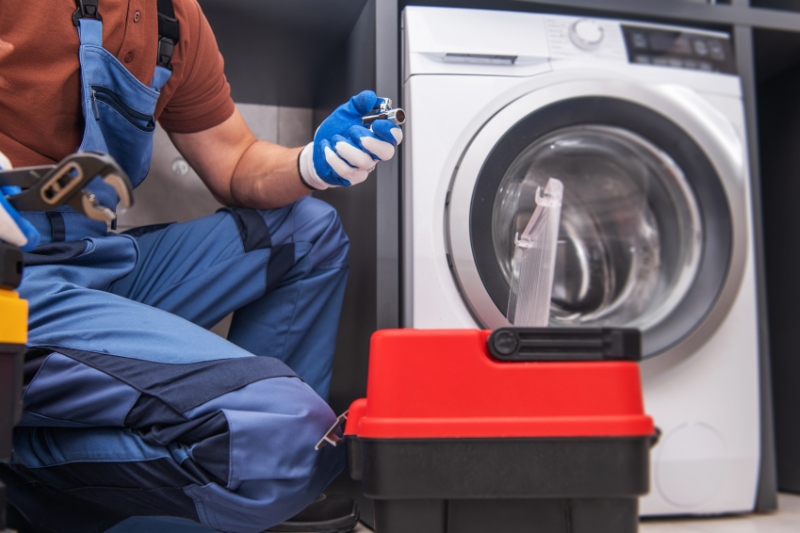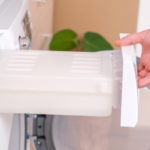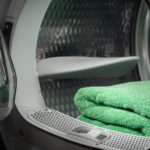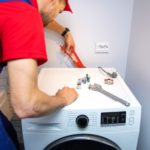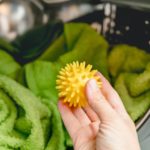Heat pump tumble dryers are a relatively new addition to the appliance market, boasting superior energy efficiency.
Like condenser dryers, heat pump dryers are much simpler to install than classic vented models as they don’t need venting.
With that said, there are several things to consider if you want to get the best out of them. From an ambient temperature to adequate air supply, read on as we explain the key heat pump tumble dryer installation requirements to bear in mind.
Does a Heat Pump Dryer Need to Be Plumbed In?
No, heat pump tumble dryers do not need to be plumbed in. Instead, they come with a built-in water tank which should be emptied after each cycle, just like a standard condenser model.
However, most models are supplied with an optional drain hose that can be attached at the back if you’d prefer. The hose can then be fed into a nearby sink or even connected to the same drain as your washing machine if they’re positioned side by side.
This way, waste water will drain away without you having to empty the tank manually each time.
Where Should a Heat Pump Dryer Be Installed?
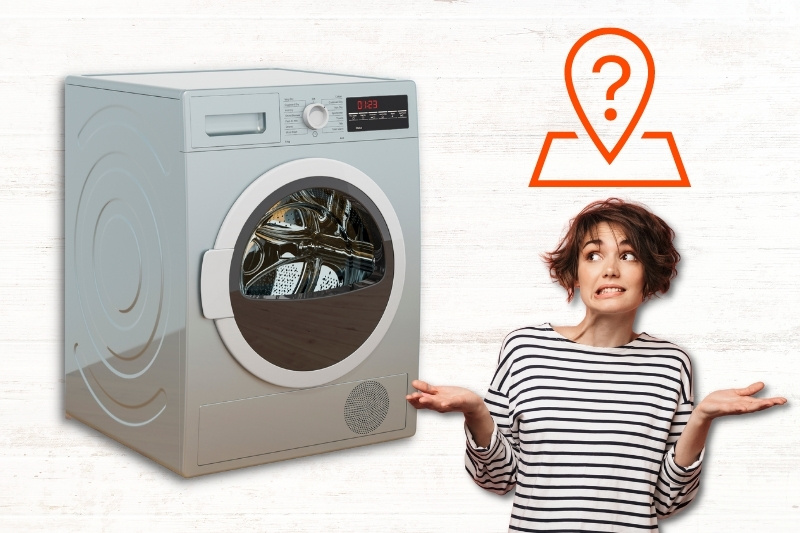
As heat pump dryers don’t require drainage or a vent, they can be installed pretty much anywhere you like, provided the room has good air supply. The reason for this is that all tumble dryers need space to breathe in order to condense moisture properly.
Ideally, the room you choose will have windows that you can open to increase the amount of fresh air. If that’s not possible, placing the appliance in a larger room or leaving the door open will also improve ventilation.
There must be a good amount of space around the air inlet at the front of the machine, plus a few centimetres around the back and sides too.
If you don’t have a dedicated utility area, a heat pump dryer can be placed under a kitchen counter, as long as there is plenty of room around it.
Even a spacious cupboard is an option, as long as you don’t close the door when it’s in use.
This flexibility makes heat pump dryers much more appealing than traditional dryers that require an external vent.
Heat Pump Dryer Installation Requirements to Consider
1. Ambient temperature between 5°C and 35°C
One key factor to consider when installing a heat pump tumble dryer is the temperature of the room it’s going in.
Many people put their dryer in a garage to save space, but this is an error. Both heat pump and condenser dryers require an ambient temperature of between 5°C and 35°C to function correctly.
Unless they are heated or air-conditioned all year round, out buildings and garages are very changeable environments. Therefore, selecting an indoor room with an average temperature of 15-25°C is a much better option.
2. Level flooring

While it may sound obvious, one of the most important heat pump tumble dryer installation requirements is level flooring. Otherwise, the machine will be off-balance, vibrate excessively and is unlikely to work correctly.
Depending on how bad the slope is, it could also leak. Due to this, you should use a spirit level to make sure your tumble dryer is sitting evenly before running it. If it isn’t, adjust the corner screw feet at the base of the machine to level it out.
3. No carpet
As well as being level, the floor you place your dryer on also needs to have a hard surface such as wood, stone or concrete for stability.
In addition, given the 50°C temperature heat pump tumble dryers can reach, carpeted floors pose a fire hazard.
Loose fibres could be sucked into the air intake by accident, while a thick carpet may block the gap between the floor and the base of the machine. This needs to be kept clear to prevent overheating, hence the slightly raised feet.
4. Dedicated socket
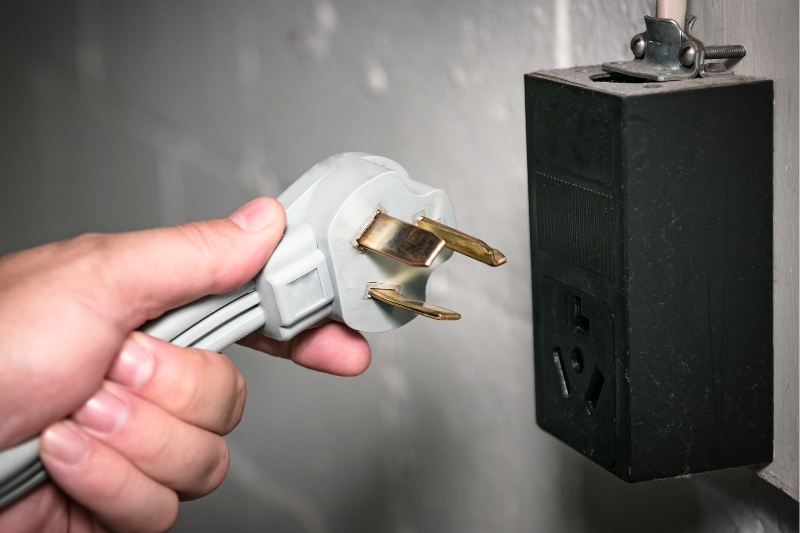
While heat pump tumble dryers can go almost anywhere, using an extension lead is not recommended.
Due to their relatively high wattage, large appliances like dryers, washing machines and fridges should all be plugged directly into a 240-volt socket to minimise the risk of electrical overheating.
The same goes for multi-block adapters, which can quickly become overloaded if more than one big item is plugged in at once.
Instead, pick a spot with a wall socket nearby or get a new one installed, and only plug one big appliance into it.
5. Close to a sink or drain
Although heat pump dryers don’t have to be plumbed in, you will still need to empty the water tank regularly. Because of this, it may be useful to position your dryer close to a sink or drain.
That way, you can simply slide out the container and pour the waste water away, without having to carry it through the house to the kitchen or bathroom. As well as being more convenient, this will also reduce the chance of spillages on carpeted floors.
6. Don’t use the machine immediately after installing it
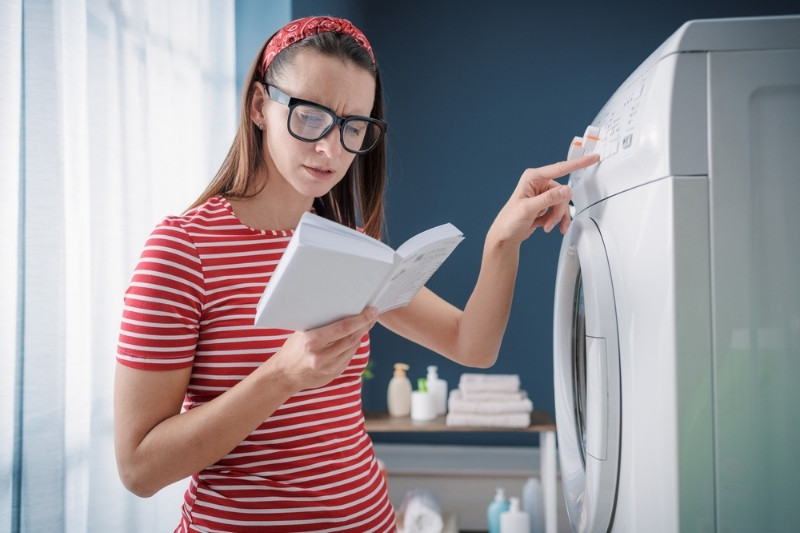
Once your dryer is in position, most manufacturers recommend leaving it to stand for a few hours before running the first cycle. This is likely to allow the refrigerant in the heat pump to settle, much like you would with a fridge or freezer.
Some suggest 2-3 hours, while others state 24 hours. This will depend on the make and model you choose, so be sure to check the instruction manual for your particular heat pump tumble dryer before getting started.
7. Seal hole in wall if required
Finally, if you previously had a vented dryer with a pipe that was fed outside through a hole in the wall, you’ll want to seal it up right away. This will prevent any draughts, moisture and pests entering your home through the newly open gap.
There are several ways to do this, but a qualified builder will be able to talk you through the best options for your property.
Want more tips for choosing and maintaining a tumble dryer? Keep exploring our site for everything from the best heat pump dryers on the market to problem-solving strange smells in the dryer.

A proud Yorkshire lass with a love for movies, music and cosy nights in! Once a self-confessed avoider of cleaning, she’s always on the lookout for new ways to make household chores as quick and simple as possible.
